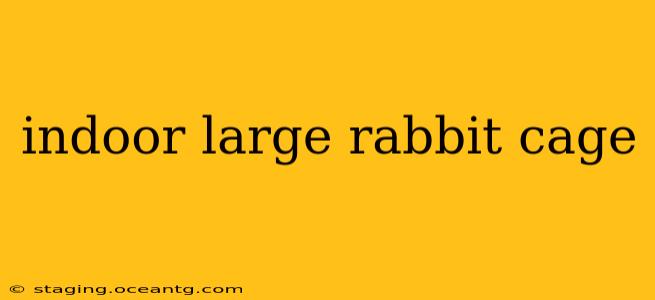Rabbits are intelligent, social animals that need ample space to thrive. Choosing the right indoor cage for your large rabbit is crucial for their well-being and happiness. This guide will help you navigate the options, address common concerns, and ensure your bunny has a comfortable and stimulating home.
What Size Cage Do I Need for a Large Indoor Rabbit?
This is a frequently asked question, and the answer isn't a simple number. The minimum recommended space for a large rabbit is significantly more than what many commercially available cages offer. As a general rule, your rabbit should have enough space to comfortably:
- Hop freely: They should be able to stretch out fully without touching the sides.
- Run and play: Consider their breed and size—a Flemish Giant will need considerably more space than a smaller breed like a Dutch rabbit.
- Have separate areas: A space for eating, sleeping, and using their litter box.
Many experts recommend a minimum floor space of at least 4 feet by 2 feet for a single large rabbit. Larger is always better! Think of it this way: would you be happy living in a cramped space? The more room you provide, the happier and healthier your rabbit will be.
What are the Best Types of Indoor Large Rabbit Cages?
Several options offer ample space for your large rabbit:
- Custom-built enclosures: These offer the ultimate flexibility in size and design, allowing you to perfectly tailor the space to your rabbit's needs. Materials like plywood are popular choices.
- Large multi-tiered cages: While some multi-level cages are too small, others offer a larger footprint with multiple levels, increasing usable space. Ensure the ramps are sturdy and the spacing between levels is safe.
- Converted furniture: A sturdy, solid-bottomed dresser or wardrobe can be easily converted into a rabbit-friendly living space with some creative modification. Ensure all paints and finishes are non-toxic.
- Large dog crates: Some heavy-duty dog crates can provide a suitable space, especially if modified with additional bedding and enrichment.
Always prioritize solid flooring over wire mesh to protect your rabbit's feet.
What Features Should I Look for in a Large Rabbit Cage?
Beyond size, several key features contribute to a rabbit's comfort and well-being:
- Solid bottom: Wire mesh bottoms can cause sore hocks (swollen feet) and are generally uncomfortable.
- Easy to clean: Rabbits can be messy, so easy access for cleaning is essential.
- Good ventilation: Ensure proper airflow to prevent ammonia buildup and respiratory problems.
- Secure latch: Prevent escapes!
Are there any downsides to using a large cage?
While larger is generally better, consider the space available in your home. A truly spacious rabbit enclosure might require a dedicated area. Also, larger cages often mean more bedding and cleaning. Weigh the benefits of a larger space against your available resources and living situation.
How do I keep my rabbit's large indoor cage clean?
Daily spot cleaning is vital to maintain hygiene. This includes removing soiled bedding and food scraps. A complete cage cleaning should be done at least weekly or bi-weekly, depending on the size of the cage and your rabbit's habits.
What is the best way to enrich a large indoor rabbit cage?
Enrichment is crucial to prevent boredom and behavioral issues. Provide a variety of toys, including:
- Chew toys: Wooden toys, cardboard boxes, and hay racks keep your rabbit's teeth trimmed and offer mental stimulation.
- Tunnels and hides: Provide safe and enclosed spaces for resting and hiding.
- Toys that encourage exploration: Puzzle feeders or foraging toys make mealtime more engaging.
Rotate toys regularly to keep your rabbit interested. Remember, a happy rabbit is an active rabbit! Ensure plenty of room for play and exercise outside the cage as well.
Can I let my large rabbit free roam my house?
Free-roaming offers significant benefits, but requires preparation:
- Rabbit-proof your house: Secure electrical cords, toxic plants, and valuable items.
- Supervise your rabbit: Always supervise them when they are outside their cage.
- Establish a safe space: A designated room or area that's rabbit-proofed offers security and a dedicated play area.
Careful planning and supervision are key to safe free-roaming.
By understanding your rabbit's needs and carefully considering the factors outlined above, you can create a comfortable, stimulating, and safe indoor environment for your furry friend. Remember, a happy rabbit is a healthy rabbit!
